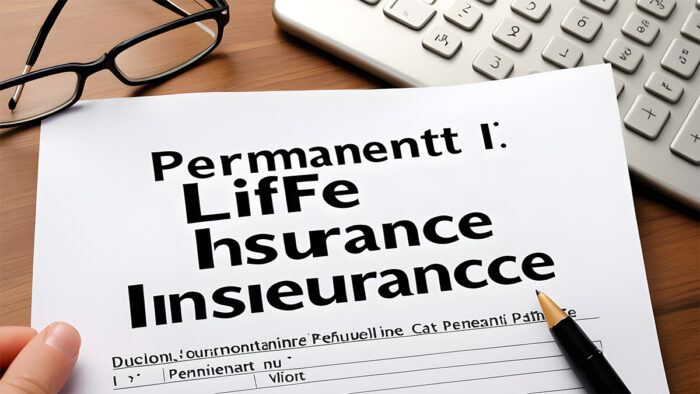Permanent life insurance is a type of life insurance that provides coverage for the entire lifetime of the insured individual, as long as premiums are paid. Unlike term life insurance, which provides coverage for a specific period (such as 10, 20, or 30 years), permanent life insurance remains in force for as long as the policyholder lives, as long as premiums are maintained.

One of the distinguishing features of this insurance policy is its cash value component. As premiums are paid, a portion of the premium goes towards the cost of insurance, while another portion goes into a cash value account, which accumulates over time.
This cash value can grow on a tax-deferred basis, meaning policyholders don’t pay taxes on the gains as long as the funds remain within the policy. Policyholders can typically access this cash value through policy loans or withdrawals, providing a potential source of funds for various financial needs.
It also offers a guaranteed death benefit, which is the amount paid out to beneficiaries upon the insured’s death. This death benefit remains in force as long as premiums are paid, providing peace of mind that loved ones will receive financial protection in the event of the insured’s passing.
How Does Permanent Life Insurance Work?
Permanent life insurance works by combining insurance protection with an investment vehicle, known as the cash value account. When you apply for this insurance policy, you make premium payments that are split between the cost of the insurance and the cash value account.
The cash value account is invested, usually in bonds or other low-risk investments, and it grows over time. You can borrow against the cash value, use it to pay premiums, or leave it to accumulate. If the policyholder dies, the death benefit is paid out to the beneficiaries.
The growth of the cash value account in a permanent life insurance policy is tax-deferred, meaning that you don’t have to pay taxes on the growth as long as the money stays in the account. The cash value can also be accessed tax-free if the policyholder takes out a loan against the account, up to a certain limit.
While it can be more expensive than term life insurance, it offers some additional benefits, such as the tax-advantaged growth of the cash value account.
Types of Permanent Life Insurance
There are several types of permanent life insurance policies available, including whole life insurance, universal life insurance, variable life insurance, and indexed universal life insurance. Each type has its own unique features, benefits, and premium structures, allowing individuals to choose a policy that aligns with their financial goals and needs.
- Whole Life Insurance: This is the most common type, offering fixed premiums and death benefits with guaranteed cash value growth. It also provides dividends that can be used to reduce premiums, received as cash, or left to accumulate interest.
- Universal Life Insurance: This type offers more flexibility in adjusting premiums and death benefits based on cash value accumulation. It includes a minimum interest rate guarantee to mitigate risks.
There are two subtypes of universal life insurance: variable and indexed.
- Variable Universal Life Insurance: This policy allows investment options to increase cash value but comes with investment risks affecting cash value and death benefits. It may also offer adjustable death benefits and premiums.
- Indexed Universal Life Insurance: This type has no fixed interest rate, potentially leading to greater gains or losses from investments. It often includes a minimum interest rate guarantee to manage risks.
Each type of permanent life insurance has its advantages and disadvantages, and the choice depends on individual needs and financial goals.
Pros and Cons
Pros
- Lifetime Coverage: It provides coverage for the entire lifetime of the insured, as long as premiums are paid.
- Cash Value: These policies accumulate cash value over time, which can be used as a source of savings, to pay future premiums, or as collateral for a repayable loan.
- Flexibility: The cash value can be used to adjust premium payments and death benefits, providing flexibility in managing the policy.
Cons
- Expensive: It is typically more expensive than term life insurance due to the lifelong coverage and investment component.
- Complexity: These policies can be more complex and challenging to understand than straightforward term insurance.
- Cancellation Fees: Some contracts may contain cancellation fees or loss of interest, so it’s essential to read the agreement carefully before signing up.
To crown it all, it offers lifelong coverage and the potential to build cash value, but it is more expensive and can be more complex than term life insurance.
How to Get Permanent Life Insurance
Follow these steps below to apply for a policy;
• Determine Your Needs
Calculate the amount of death benefit you require and how long you want coverage. Consider consulting a financial advisor to assess your needs accurately.
• Application Process
Apply for the desired permanent life insurance policy. This typically involves a health screening to determine your insurability.
• Premium Payment
Decide on the length of time you want to pay your premiums, whether it’s for your entire life, a specific number of years, until you reach a certain age, or in a lump sum.
• Cash Value Accumulation
Understand how the cash value component works in your policy. Cash value accumulates over time and can be accessed through loans or withdrawals.
Remember that permanent life insurance is more expensive than term life insurance due to its lifelong coverage and cash value component. It is crucial to choose the right type of permanent life insurance that aligns with your financial goals and needs.
Cost of Permanent Life Insurance
The cost of permanent life insurance varies based on factors such as the insured’s age, health status, desired coverage amount, and the type of policy chosen, with premiums typically being higher compared to term life insurance due to the lifelong coverage and cash value accumulation features inherent to permanent policies.
The cost can also vary depending on the insurer and individual circumstances. Shopping around and comparing quotes from different companies can help you find the best rates.
Who Should Consider Permanent Life Insurance?
Permanent life insurance is a good choice for people who want lifelong coverage and are comfortable with the higher premiums. It’s also a good option for people who want to use the cash value for estate planning or other long-term financial goals.
People who are looking for more flexibility in their life insurance policy may also prefer it over term life insurance. That said, it is not for everyone. Some people may prefer the lower premiums of term life insurance or may not need lifelong coverage.
FAQS
Is permanent life insurance a good investment?
Permanent life insurance can provide lifelong coverage and a guaranteed death benefit. But it’s not necessarily the best investment option for everyone. The cash value account can grow over time, but it may not grow as much as other types of investments.
Is it worth it?
Permanent life insurance can be a good option for people who want lifelong coverage and the ability to access the cash value. It can also be a useful tool for estate planning.
However, it is not the best option for everyone, and it’s important to weigh the pros and cons before deciding.
Is permanent life insurance tax-deductible?
The premiums are not tax-deductible. However, the death benefit is generally tax-free. In addition, the cash value account can grow tax-deferred, meaning that you won’t have to pay taxes on the growth until you withdraw the money.
The tax implications of permanent life insurance can be complex, and it’s important to consult with a tax advisor to understand how it may affect your situation.


